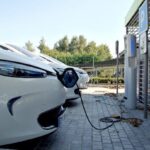
Driving into the Future: A Comprehensive Exploration of Automotive Innovation
January 18, 2024
The Art and Science of Vehicle Aerodynamics and Design
January 27, 2024Driving Innovation: A Deep Dive into the Future of Automotive Technology
Introduction:
The automotive industry is undergoing a profound transformation, driven by a wave of technological advancements that promise to reshape the way we perceive, interact with, and use vehicles. In this comprehensive exploration, we will delve into a dozen cutting-edge technologies that are pushing the boundaries of what’s possible in the world of automobiles.
Solid-State Batteries: Paving the Way for Electric Vehicles of Tomorrow
The advent of solid-state batteries holds immense promise for the electric vehicle (EV) revolution. These advanced batteries offer a higher energy density, addressing concerns about EV range and charging speed. With a solid electrolyte replacing the traditional liquid electrolyte, these batteries are not only safer but also more efficient. The potential for extended range and faster charging times could be a game-changer in the widespread adoption of electric vehicles.
Augmented Reality in Car Navigation: Navigating the Future Seamlessly
The integration of augmented reality (AR) into car navigation systems is transforming the driving experience. AR overlays real-time information onto the driver’s field of vision, providing intuitive and immersive guidance. From highlighting upcoming turns to displaying real-time traffic information, AR navigation enhances safety and convenience, marking a significant leap forward in in-car technology.
Blockchain Technology in Automotive: Revolutionizing Trust and Transparency
Blockchain technology is making waves in the automotive industry, promising enhanced security, transparency, and efficiency. From secure transactions and supply chain management to tracking vehicle history, blockchain ensures an unalterable and decentralized record. This not only safeguards against fraud but also streamlines processes, offering a new paradigm for trust in the automotive ecosystem.
Advanced Materials in Car Manufacturing: Lightweight and Strong for a Sustainable Future
Innovative materials such as carbon fiber, graphene, and aluminum alloys are redefining car manufacturing. These materials contribute to the production of lighter, stronger, and more fuel-efficient vehicles. With a focus on sustainability, car manufacturers are increasingly adopting these advanced materials to meet stringent environmental standards without compromising on performance.
Personalized In-Car Experiences: AI-Driven Comfort and Convenience
Car manufacturers are leveraging artificial intelligence (AI) and machine learning to create personalized in-car experiences. From adaptive lighting that responds to driver preferences to customized infotainment systems, AI tailors the driving environment to individual needs. This personalization enhances comfort and convenience, making each journey a unique and enjoyable experience.
Mobility as a Service (MaaS): Redefining Urban Transportation
The rise of Mobility as a Service (MaaS) platforms is reshaping urban transportation. These platforms integrate various transportation services into a single, accessible solution. By offering a seamless experience that combines public transit, ride-sharing, and other mobility services, MaaS is changing the way people perceive and use cars, promoting efficiency and sustainability in urban mobility.
Vehicle-to-Everything (V2X) Communication: Enhancing Safety and Efficiency
Vehicle-to-everything (V2X) communication enables vehicles to communicate with each other and their surroundings. This technology improves safety, traffic management, and overall efficiency on the road. From collision avoidance to traffic signal optimization, V2X communication holds the potential to revolutionize the way vehicles interact within a connected ecosystem.
Biometric Vehicle Access: Secure and Convenient Entry
Biometric technologies, including fingerprint recognition and facial recognition, are becoming integral to secure and convenient vehicle access. By replacing traditional key-based systems, biometric access enhances security while offering a frictionless entry experience. This technology not only prevents unauthorized access but also adds a touch of sophistication to modern vehicles.
3D Printing in Automotive Manufacturing: Revolutionizing Production Processes
3D printing is disrupting traditional manufacturing processes in the automotive industry. From rapid prototyping to the production of complex parts and components, 3D printing offers flexibility, efficiency, and cost-effectiveness. This technology is unlocking new possibilities in design and manufacturing, enabling the creation of intricate and customized automotive components.
Regenerative Braking Systems: Harnessing Energy for Efficiency
The latest developments in regenerative braking technology are capturing and storing energy during braking, significantly improving the efficiency of electric and hybrid vehicles. By converting kinetic energy into electrical energy, regenerative braking systems contribute to increased range and reduced energy consumption, making these vehicles more sustainable and practical.
Smart City Integration: Cars in the Heart of Urban Innovation
Cars are becoming integral components of smart city ecosystems. By connecting with urban infrastructure, vehicles contribute to improved traffic flow, parking solutions, and overall urban mobility. Smart city integration ensures a seamless and efficient transportation experience, transforming the way we navigate and interact with our urban environments.
Holographic Displays in Cars: Futuristic Interfaces for Enhanced Experiences
The use of holographic displays in car interiors is redefining the way drivers and passengers interact with vehicle systems. Offering futuristic and interactive interfaces for navigation, entertainment, and driver assistance, holographic displays provide a glimpse into the future of in-car technology. These immersive displays enhance the overall driving experience by combining functionality with a touch of innovation.
Conclusion:
In conclusion, the automotive industry is at the forefront of a technological revolution, with innovations ranging from advanced batteries to personalized in-car experiences. As these technologies continue to evolve, they not only enhance the performance, safety, and efficiency of vehicles but also redefine the way we perceive and interact with automobiles. The future of driving is undoubtedly exciting, promising a convergence of cutting-edge technologies that will shape the automotive landscape for years to come.
FAQs:
- Are solid-state batteries available in commercial electric vehicles?
- While solid-state batteries are still in the research and development phase, some companies aim to introduce them in commercial electric vehicles in the coming years.
- How does augmented reality improve car navigation?
- Augmented reality overlays real-time information onto the driver’s field of vision, providing intuitive guidance, real-time traffic updates, and enhancing overall navigation accuracy.
- What are the key advantages of using blockchain in the automotive industry?
- Blockchain ensures secure transactions, enhances supply chain transparency, and provides an unalterable record of vehicle history, reducing fraud and improving overall efficiency.
- How do biometric vehicle access systems work?
- Biometric vehicle access systems use technologies such as fingerprint recognition and facial recognition to verify the identity of the user, granting secure and convenient access to the vehicle.
- Can 3D printing be used for mass production of automotive components?
- While 3D printing is currently used for prototyping and producing complex components, advancements are being made to scale up the technology for mass production in the automotive industry.
- What is the primary benefit of regenerative braking systems in electric vehicles?
- Regenerative braking systems capture and store energy during braking, contributing to increased energy efficiency and extended range in electric and hybrid vehicles.


